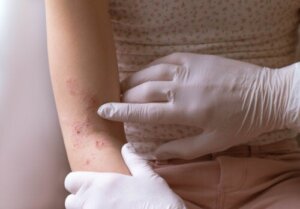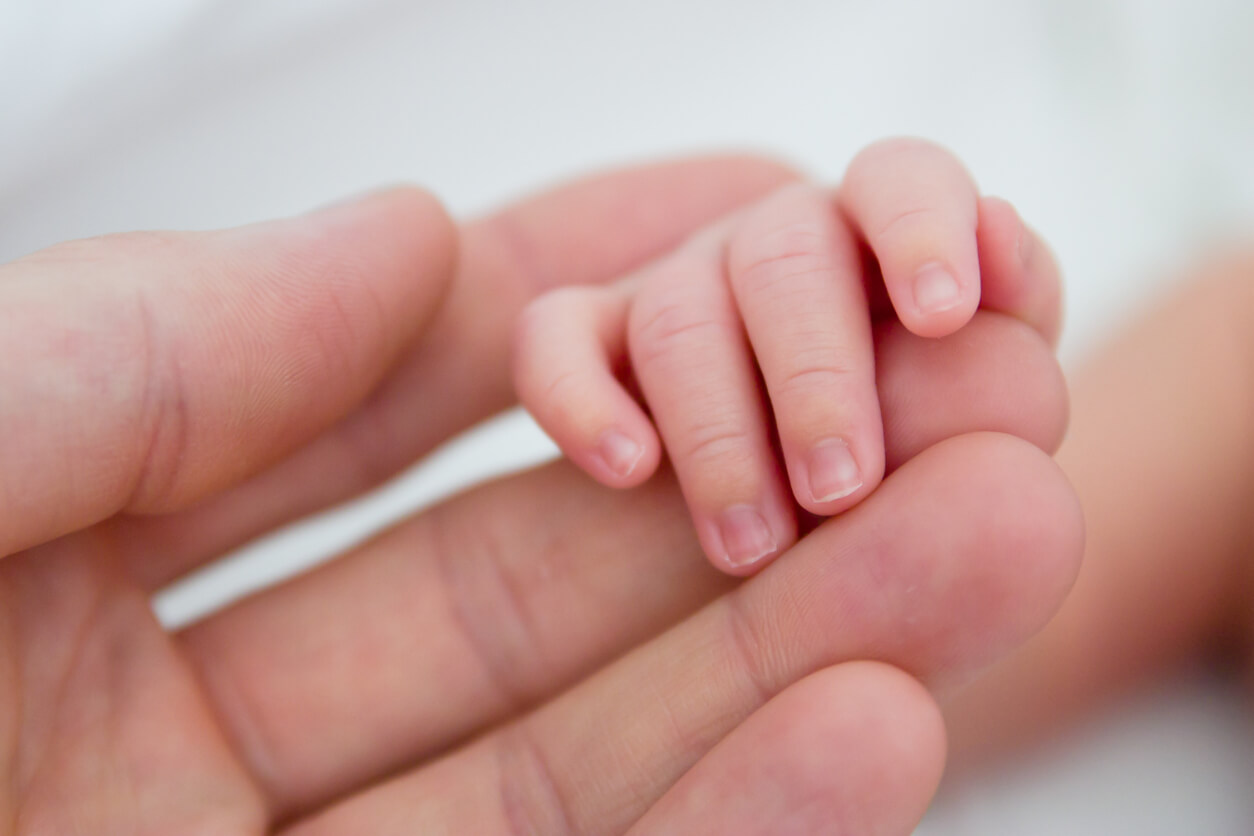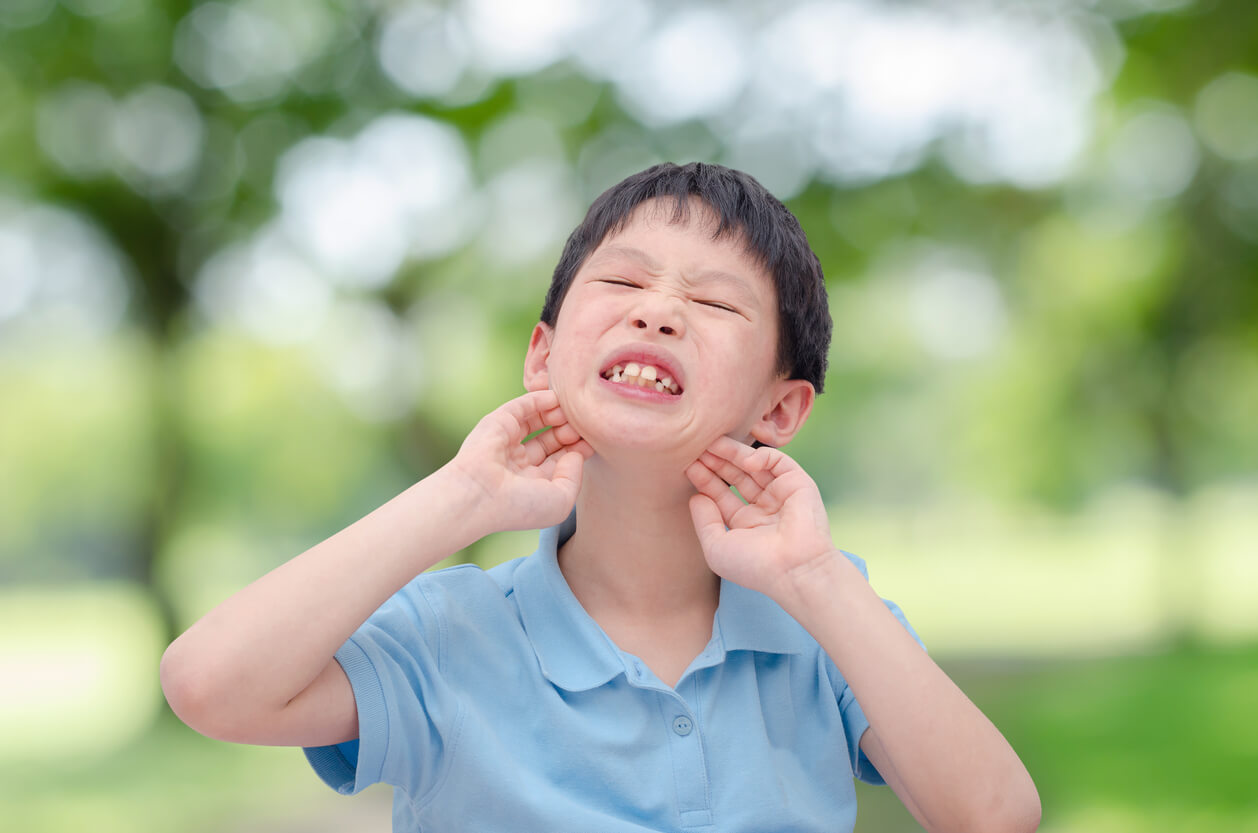The 10 Most Common Skin Problems in the First Year of Life


Written and verified by the dermatologist Maria del Carmen Hernandez
The most common skin problems in children usually manifest themselves in different ways during the first year of life. In fact, many of them are usually transitory and disappear spontaneously with the passage of time. In this article, we’ll explain 10 of the most frequent diseases and their respective characteristics.
1. Baby acne
Baby acne is a common skin condition that can appear on the face or body. It’s usually temporary and, in most cases, resolves on its own without requiring treatment.
It manifests in the form of small white or red pimples in the first few months of life, due to maternal or infant hormones, according to a Dermatology review.
2. Atopic dermatitis
Atopic dermatitis is one of the most common skin problems in children. It’s a disorder of the superficial layer of the skin surface characterized by dryness, itching, and scratching, with episodes of flares and remissions.
This type of eczema affects 5-20% of children and its treatment is aimed at suppressing inflammation, reducing itching, and eliminating the triggers of the clinical picture. The mainstays of treatment are topical moisturizers, corticosteroids, and calcineurin inhibitors.
You may be interested in: Soaps for Children with Atopic Skin
3. Scratches
Newborns are usually born with small but long nails. In addition, they’re quite sharp, and any friction or movement can hurt their delicate and sensitive skin. In most cases, the injuries caused don’t require the intervention of a professional but resolve spontaneously.

4. Impetigo, one of the most common skin problems in children
Impetigo’s an infection of the most superficial layers of the skin that’s characterized by reddened plaques with a yellow crust covering them. In addition, it spreads very easily as it’s highly contagious.
Cuts, trauma, insect bites, or atopic dermatitis injure the skin surface and promote autoinoculation at other sites. Therapeutic options include topical antibiotics, oral antibiotics, and symptomatic care.
5. Psoriasis
Psoriasis is a chronic skin condition that accelerates the production of the most superficial cells. In turn, these begin to accumulate and form red, scaly patches. This isn’t a contagious condition and, in children, the onset is usually preceded by an infection. In fact, colds can be a common trigger in infants.
6. Cradle cap
Also known as seborrheic dermatitis, this is a skin condition that appears in the form of scaling on a non-inflammatory basis in the first few weeks of life. In most cases, it disappears on its own without requiring treatment.
It’s usually located in areas with a large number of sebaceous glands such as the scalp, ears, or T-line of the face. According to the American Academy of Pediatrics, when the condition doesn’t improve after conservative measures, it can be treated with 2% ketoconazole or 1% hydrocortisone for 1 to 2 weeks.
Read also: Interesting Facts About Cradle Cap
7. Molluscum contagiosum
This infectious dermatosis is transmitted by direct contact with infected skin. It tends to resolve spontaneously over a period of 6 to 9 months.
Round, firm papules appear that are the same color as the skin, with a central umbilication and a characteristic sheen. There are various therapeutic options including chemical, mechanical, immunomodulatory, and antiviral treatment. In children, the main areas affected are exposed skin areas such as the extremities, trunk, genitalia, and face.
8. Urticaria
Urticaria is produced when there’s contact with an allergen and causes raised patches of skin that disappear over time. The most characteristic symptoms appear on the face, hands, genitals, or feet and may be as follows:
- Pruritus
- Skin edema
- Red or pink welts

9. Hand, foot, and mouth disease
Hand, foot, and mouth disease is a common and highly contagious viral disease. It usually begins with a fever, runny nose, and sore throat like a common cold. However, it’s followed by a rash and tiny blisters in the mouth, palms of the hands, soles of the feet, and buttocks. Treatment is symptomatic. Fever and pain should be relieved with analgesics.
10. Diaper rash, one of the most common skin problems in children
Diaper rash is one of the most frequent dermatoses occurring in children. It’s characterized by the appearance of erythema, pustules, and papules in the diaper area. Some of the causes are as follows:
- Overhydration of the skin
- Prolonged exposure to urine or feces
- Friction
- Elevated skin pH
- Alterations of the cutaneous microbiome
The treatment of diaper rash has two main objectives:
- Preventing the recurrence of the rash
- Healing of damaged skin
Maintaining the natural protective barrier of the skin
The maintenance and care of the acid mantle of the skin are among the essential recommendations when it comes to preventing skin problems in children and infants. Therefore, constant and adequate moisturizing should be carried out.
Children’s skin is more delicate and sensitive than that of adults. Consequently, sunscreen should be applied daily to all exposed areas of the body.
The most common skin problems in children usually manifest themselves in different ways during the first year of life. In fact, many of them are usually transitory and disappear spontaneously with the passage of time. In this article, we’ll explain 10 of the most frequent diseases and their respective characteristics.
1. Baby acne
Baby acne is a common skin condition that can appear on the face or body. It’s usually temporary and, in most cases, resolves on its own without requiring treatment.
It manifests in the form of small white or red pimples in the first few months of life, due to maternal or infant hormones, according to a Dermatology review.
2. Atopic dermatitis
Atopic dermatitis is one of the most common skin problems in children. It’s a disorder of the superficial layer of the skin surface characterized by dryness, itching, and scratching, with episodes of flares and remissions.
This type of eczema affects 5-20% of children and its treatment is aimed at suppressing inflammation, reducing itching, and eliminating the triggers of the clinical picture. The mainstays of treatment are topical moisturizers, corticosteroids, and calcineurin inhibitors.
You may be interested in: Soaps for Children with Atopic Skin
3. Scratches
Newborns are usually born with small but long nails. In addition, they’re quite sharp, and any friction or movement can hurt their delicate and sensitive skin. In most cases, the injuries caused don’t require the intervention of a professional but resolve spontaneously.

4. Impetigo, one of the most common skin problems in children
Impetigo’s an infection of the most superficial layers of the skin that’s characterized by reddened plaques with a yellow crust covering them. In addition, it spreads very easily as it’s highly contagious.
Cuts, trauma, insect bites, or atopic dermatitis injure the skin surface and promote autoinoculation at other sites. Therapeutic options include topical antibiotics, oral antibiotics, and symptomatic care.
5. Psoriasis
Psoriasis is a chronic skin condition that accelerates the production of the most superficial cells. In turn, these begin to accumulate and form red, scaly patches. This isn’t a contagious condition and, in children, the onset is usually preceded by an infection. In fact, colds can be a common trigger in infants.
6. Cradle cap
Also known as seborrheic dermatitis, this is a skin condition that appears in the form of scaling on a non-inflammatory basis in the first few weeks of life. In most cases, it disappears on its own without requiring treatment.
It’s usually located in areas with a large number of sebaceous glands such as the scalp, ears, or T-line of the face. According to the American Academy of Pediatrics, when the condition doesn’t improve after conservative measures, it can be treated with 2% ketoconazole or 1% hydrocortisone for 1 to 2 weeks.
Read also: Interesting Facts About Cradle Cap
7. Molluscum contagiosum
This infectious dermatosis is transmitted by direct contact with infected skin. It tends to resolve spontaneously over a period of 6 to 9 months.
Round, firm papules appear that are the same color as the skin, with a central umbilication and a characteristic sheen. There are various therapeutic options including chemical, mechanical, immunomodulatory, and antiviral treatment. In children, the main areas affected are exposed skin areas such as the extremities, trunk, genitalia, and face.
8. Urticaria
Urticaria is produced when there’s contact with an allergen and causes raised patches of skin that disappear over time. The most characteristic symptoms appear on the face, hands, genitals, or feet and may be as follows:
- Pruritus
- Skin edema
- Red or pink welts

9. Hand, foot, and mouth disease
Hand, foot, and mouth disease is a common and highly contagious viral disease. It usually begins with a fever, runny nose, and sore throat like a common cold. However, it’s followed by a rash and tiny blisters in the mouth, palms of the hands, soles of the feet, and buttocks. Treatment is symptomatic. Fever and pain should be relieved with analgesics.
10. Diaper rash, one of the most common skin problems in children
Diaper rash is one of the most frequent dermatoses occurring in children. It’s characterized by the appearance of erythema, pustules, and papules in the diaper area. Some of the causes are as follows:
- Overhydration of the skin
- Prolonged exposure to urine or feces
- Friction
- Elevated skin pH
- Alterations of the cutaneous microbiome
The treatment of diaper rash has two main objectives:
- Preventing the recurrence of the rash
- Healing of damaged skin
Maintaining the natural protective barrier of the skin
The maintenance and care of the acid mantle of the skin are among the essential recommendations when it comes to preventing skin problems in children and infants. Therefore, constant and adequate moisturizing should be carried out.
Children’s skin is more delicate and sensitive than that of adults. Consequently, sunscreen should be applied daily to all exposed areas of the body.
All cited sources were thoroughly reviewed by our team to ensure their quality, reliability, currency, and validity. The bibliography of this article was considered reliable and of academic or scientific accuracy.
- Lucky AW. A review of infantile and pediatric acne. Dermatology. 1998;196(1):95-7. doi: 10.1159/000017838. PMID: 9557239.
- Nardi NM, Schaefer TJ. Impetigo. 2020 Nov 21. In: StatPearls [Internet]. Treasure Island (FL): StatPearls Publishing; 2021 Jan–. PMID: 28613693.
- Leung AKC, Barankin B, Hon KLE. Molluscum Contagiosum: An Update. Recent Pat Inflamm Allergy Drug Discov. 2017;11(1):22-31. doi: 10.2174/1872213X11666170518114456. PMID: 28521677.
This text is provided for informational purposes only and does not replace consultation with a professional. If in doubt, consult your specialist.








